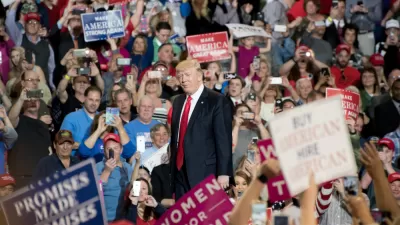The Republican nominee for president announced the early sketches of a sweeping infrastructure investment program—touted as at least doubling the program proposed by the Clinton campaign.
"Donald Trump on Tuesday proposed a plan to rebuild U.S. infrastructure that costs 'at least double' the amount that Hillary Clinton has floated, in what would amount to a massive new government program," reports Sahil Kapur.
Kapur compares the proposal announced by Trump to the infrastructure plan proposed by the Hillary Clinton Campaign and also notes the difficulty Trump might find in building support for the plan from within his own party. " The political viability of a massive new infrastructure plan is also doubtful, as Republicans have spent years battling new taxes and government spending," writes Kapur.
Trump made his case for the Fox Business Network, saying he'd pay for the plan with a fund, with money provided by "people" and "investors," as well as "infrastructure bonds from the country, from the United States." Kapur also calls out the vagueness of Trump's funding plans.
FULL STORY: Trump Says He’ll Spend More Than $500 Billion on Infrastructure

Maui's Vacation Rental Debate Turns Ugly
Verbal attacks, misinformation campaigns and fistfights plague a high-stakes debate to convert thousands of vacation rentals into long-term housing.

Planetizen Federal Action Tracker
A weekly monitor of how Trump’s orders and actions are impacting planners and planning in America.

San Francisco Suspends Traffic Calming Amidst Record Deaths
Citing “a challenging fiscal landscape,” the city will cease the program on the heels of 42 traffic deaths, including 24 pedestrians.

Defunct Pittsburgh Power Plant to Become Residential Tower
A decommissioned steam heat plant will be redeveloped into almost 100 affordable housing units.

Trump Prompts Restructuring of Transportation Research Board in “Unprecedented Overreach”
The TRB has eliminated more than half of its committees including those focused on climate, equity, and cities.

Amtrak Rolls Out New Orleans to Alabama “Mardi Gras” Train
The new service will operate morning and evening departures between Mobile and New Orleans.
Urban Design for Planners 1: Software Tools
This six-course series explores essential urban design concepts using open source software and equips planners with the tools they need to participate fully in the urban design process.
Planning for Universal Design
Learn the tools for implementing Universal Design in planning regulations.
Heyer Gruel & Associates PA
JM Goldson LLC
Custer County Colorado
City of Camden Redevelopment Agency
City of Astoria
Transportation Research & Education Center (TREC) at Portland State University
Jefferson Parish Government
Camden Redevelopment Agency
City of Claremont




























